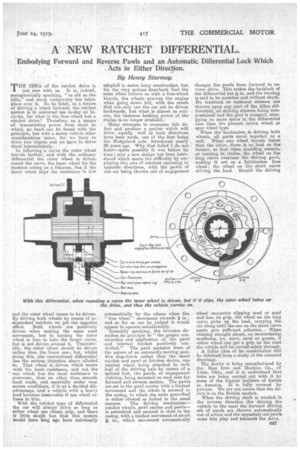A NEW RATCHET DIFFERENTIAL.
Page 33

If you've noticed an error in this article please click here to report it so we can fix it.
Embodying Forward and Reverse Pawls and an Automatic Differential Lock Which Acts in Either Direction.
By. Henry Sturrney.
THE IDEA of the ratchet drive is not new with us. It is, indeed, snetaphorically speaking, "as old as the hills," and much controversy has taken place over it. To be brief, as a means of driving a wheel forward, the ratchet system is in universal use to-day on bicycles, for what is the free wheel but a ratchet drive? Therefore, as it means of transmitting power from shaft to wheel, go fault eau be found with the principle, but with a motor vehicle other considerations enter, for we have to drive two wheels and we have to drive them intermittently.
In following a curve the outer wheel travels farther, andt with the ordinary differential the outer wheel is driven. round the curve, the inner wheel for the moment acting as a fulcrum, but if the inner wheel slips the resistance is lest
and the outer wheel ceases to be driven. By driving both wheels by means of independent ratchets we get the opposite effect. Both wheels are positively driven when making the same road movement, but in turning the outer wheel is free to take the larger curve, but is not driven around it. Theoretically, the outer wheel should be driven rather than the inner one; but, whilst doing this, the conventional differential has the serious objection above alluded to. That wheel is driven which meets with the least resistance' and not the one which has the most resistance to overcome, thus on other than smooth hard roads, and especially under very severe conditions, it is at a decided disadvantage, and a vehicle with a heavy load becomes imanovable if one wheel refuses to bite.
With the ratchet type of differential the car will always drive so long as either wheel can obtain grip, and there is little doubt but that this system would have long ago been universally adopted in motor lorry construction, but for the very serious drawback that the same effect follows as with a free-wheel bicycle, the wheels overrun the engine when going down hill, with the result that not only can the car not be driven backwards, but what is almost as serious, the immense braking power of the engine is no longer available.
Many attempts to overcome this defect and produce a system which will drive equally well in both directions have been made, one of the first being the Hedgeland axle, introduced nearly 20 years ago. Why that failed I do not know—quite possibly it was before its time ; now a new design has been introduced which meets the difficulty by emcloying two sets of ratchets operating in opposite directions, with the pawls of one set being thrown out of engagement
automatically by the others when the "free wheel" movement exceeds in., and so far as can be judged it would appear to operate satisfactorily.
Generally speaking, the inventor describes its principle as "the proper construction and application of the pawl and internal ratchet positively controlled." The pawl partakes more of the nature of an outwardly-moving positive dog-clutch rather than the usual ratchet and pawl or friction device, one ratchet wheel being attached to each half of the driving axle by means of a splined hub, the pawls, or engagement clutches, being mounted, on each side for forward and reverse motion. The paiila are set in the pawl carrier with a limited movement and the whole is secured in. the casing, to which the main gearwheel is either riveted or bolted in the usual manner. The driving mechanism— ratchet wheels, pawl carrier and pa,w1sis assembled and secured in slots in the casing, with a limited movement of about in., which movement automatically changes the pawls from forward to reverse drive. This makes the backlash of the differential but. in. and the running is said to be noiseless and without shock. No tensional or torsional stresses are thrown upon any part of the Allen differential, all driving stresses being compressional and the gear is compact, occupying no more space in the differential ease than the present crown wheel or spur wheel type. When the'mechanism, is driving both wheels, all parts move together as a unit. When one wheel travels faster than the other, there is no load on the former, so that when rounding corners, or running in circles, the wheel on the long curve overruns the driving pawl, snaking it act as a frictionless free wheel ; the wheel on the short curve driving the load. Should the driving wheel encounter slipping mud or sand and lose its grip, the wheel on the long curve picks up the load, carrying the car along until the one on the short curve again gets sufficient adhesion. When running straight ahead, on encountering mndholes, ice, snow, sand or grease, if either wheel can get a grip on the road the vehicle will be carried safely through.
A fuller idea of its construction will be obtained from a study of the annexed drawings.
The device is being manufactured by the East Iron and Machine Co., of Lima, Ohio, and it is understood that tests are being carried out with it by some of the biggest builders of lorries in. America. It is fully covered by patents. We are not aware that the deAire is on the British market.
When the driving shaft is rotated, in the reverse direction (for driving the vehicle to the rear) the forward driving set of pawls are thrown automatically out of action and the oppositely-set pawls come into play and transmit the drive.










































